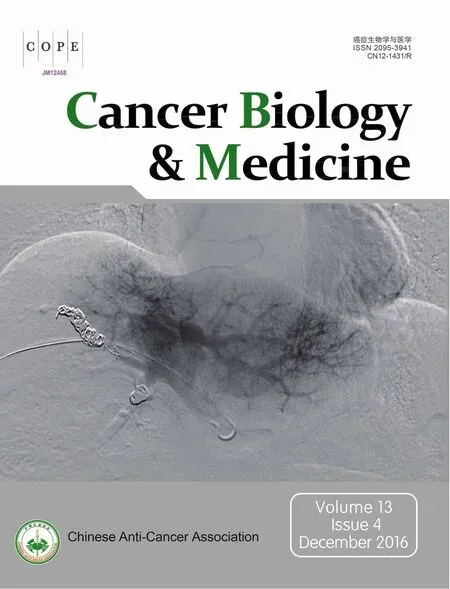Liver cancer: challenge and prospect
Qiang Li
Department of Hepatobiliary Cancer, Tianjin Medical University Cancer Institute and Hospital, National Clinical Research Center for Cancer, Tianjin Key Laboratory of Cancer Prevention and Therapy, Tianjin Clinical Research Center for Cancer, Tianjin 300060, China
GUEST EDITOR’S PREFACE
Liver cancer: challenge and prospect
Qiang Li
Department of Hepatobiliary Cancer, Tianjin Medical University Cancer Institute and Hospital, National Clinical Research Center for Cancer, Tianjin Key Laboratory of Cancer Prevention and Therapy, Tianjin Clinical Research Center for Cancer, Tianjin 300060, China

Professor Qiang Li graduated from Tianjin Medical University and got systematic training in surgical oncology in Princess Alexander Hospital of University of Queensland. He is expertised in surgical treatment of liver cancer, pancreatic cancer, and cholangiocarcinoma, especially in resection of high bile duct carcinoma and hilar cholangiocarcinoma. He is now vice president of Tianjin Medical University, chairman of liver cancer special committee of the Chinese Anti-Cancer Association, president of Tianjin Anti-Cancer Association, and editorial board members of Chinese Medical Journal, Chinese Journal of Hepatobiliary Surgery, Chinese Journal of Clinical Oncology, and Cancer Biology & Medicine. He has received awards and honors including Second Prize of National Science and Technology Progress Award, Chinese Medical Science and Technology Award, Second Prize of Tianjin Science and Technology Progress Award, and New Century Excellent Talents of Chinese Ministry of Education.
According to GLOBOCAN 2012, liver cancer is the sixth most common cancer in the world. There were 782,000 new cases diagnosed in 2012, with 50% in China alone. Liver cancer is the second most common cause of cancer death worldwide and its prognosis is very poor. The World Health Organization (WHO) declared 745,517 deaths caused by liver cancer in 2012, with more than half from China1.
Evidence has revealed that HBV or HCV infection, alcohol consumption, exposure to aflatoxins, intake of food contaminated with aflatoxins, and pollution in the soil, water, and air are risk factors of liver cancer. Nonalcoholic fatty liver disease has recently been noticed as a cause of liver cancer. At present, surgery is still the mainstay of treatment for liver cancer. Patient survival rate can be increased through a comprehensive therapy based on surgery.
As a disease with high mortality and morbidity in China, liver cancer is a big threat to public health. During the past decade, Chinese scholars have obtained a series of findings in mechanisms of liver carcinogenesis including gene mutations, liver cancer stem cells, microenvironment, and abnormal metabolism. Meanwhile, the diagnosis and treatment of liver cancer has greatly improved, achieving a 5-year survival rate of about 50%, which is higher than that in other countries. However, the incidence of liver cancer in China is still increasing, implicating that we need to further our understanding of the biological behaviors of liver cancer. Due to the large high-risk population of 120 million with HBV infection, early detection and precision treatment will be a great challenge2. A joint effort of researchers worldwide is warranted to further elucidate the regulation of liver carcinogenesis and molecular mechanisms of recurrence, make new treatment strategies, and promote translation of new technologies.
We organized this special issue to highlight recent advances in liver cancer research and treatment. The content involves microRNAs in inflammation-associated liver cancer, application of three-dimensional printing in hepatic surgery, and portal vein embolization for induction of selective hepatic hypertrophy prior to major hepatectomy, etc. The authors include excellent Chinese scholars in liver cancer research and an internationally recognized expert Dr. David Madoff, who also contributed the cover figure. I am greatly appreciated to their kind support and the invitation from Cancer Biology & Medicine to be the guest editor.
Conflict of interest statement
No potential conflicts of interest are disclosed.
1.Torre LA, Bray F, Siegel RL, Ferlay J, Lortet-Tieulent J, Jemal A. Global cancer statistics, 2012. CA Cancer J Clin. 2015; 65: 87-108.
2.Lv GS, Chen L, Wang HY. Research progress and prospect of liver cancer in China. Sheng Ming Ke Xue (in Chinese). 2015; 27:237-248.
Cite this article as:Li Q. Liver cancer: challenge and prospect. Cancer Biol Med. 2016; 13: 405- 406. doi: 10.20892/j.issn.2095-3941.2016.0097
Qiang Li
E-mail: liqiang4016@yahoo.com
Received November 28, 2016; accepted December 5, 2016.
Available at www.cancerbiomed.org
Copyright ? 2016 by Cancer Biology & Medicine
 Cancer Biology & Medicine2016年4期
Cancer Biology & Medicine2016年4期
- Cancer Biology & Medicine的其它文章
- Work-up and management of a high-risk patient with primary central nervous system lymphoma
- Leptin influences estrogen metabolism and increases DNA adduct formation in breast cancer cells
- Ki-67 as a prognostic marker according to breast cancer molecular subtype
- Properties and feasibility of using cancer stem cells in clinical cancer treatment
- Human endogenous retroviruses and cancer
- Molecular landscape in acute myeloid leukemia: where do we stand in 2016
